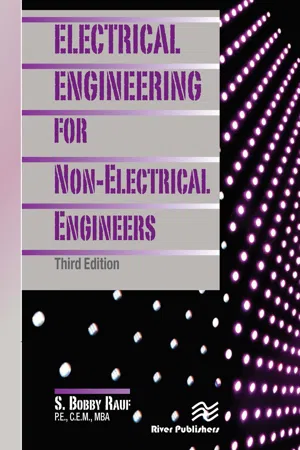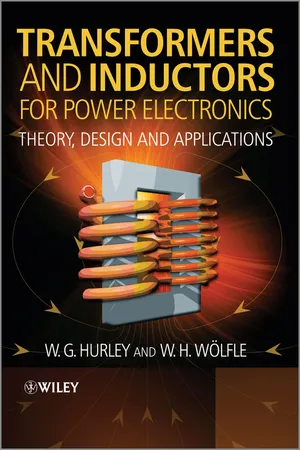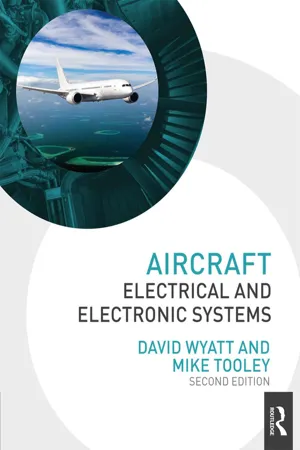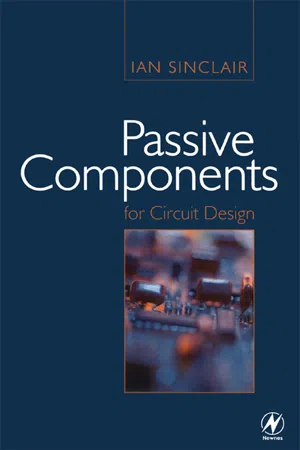Physics
Inductor Examples
Inductor examples include coils of wire, solenoids, and electromagnets. These components store energy in the form of a magnetic field when an electric current passes through them. Inductors are commonly used in electronic circuits to control the flow of current and to store and release energy.
Written by Perlego with AI-assistance
Related key terms
Related key terms
1 of 4
Related key terms
1 of 3
8 Key excerpts on "Inductor Examples"
- S. Bobby Rauf(Author)
- 2021(Publication Date)
- River Publishers(Publisher)
Conversely, when a switch — in a de-energized inductive circuit — is closed to connect a power source to an inductive device, no current flows through the circuit, initially, as inductance of the inductor in the electrical circuit opposes the change in the flow of current from “zero” to some measurable “non-zero” level. Therefore, inductance is defined as the capacity or tendency of an inductor to resist the change in flow of current. In addition, it is worth noting that just like the kinetic energy stored in a rotating flywheel can be “tapped” to perform mechanical work, the energy stored in the magnetic field of a “charged” inductor can be released to push a ferromagnetic cylindrical core, in one direction or another, to open or close a valve, or to open or close an electrical switch. The former application is an example of a solenoid operated valve, while the latter represents the operation of a contactor or a relay. The principle of inductance and physical aspects of inductors (or coils) are illustrated in Figure 1.16 (a) and (b). Basically, if you take a straight piece of wire, as shown in Figure 1.16 (a), and wind it around a cylindrical core, the final product would be a coil or an inductor. As shown in Figure 1.16 (a), current flowing through a straight wire produces a “weak” magnetic field. The current flowing through a “coiled” conductor produces a stronger and denser magnetic field, capable for conducting “work,” such as, pushing of a “plunger” against the restraint of a spring, to open or close a valve or to open or close an electrical circuit in a relay or a contactor. Figure 1.16 : (a) Straight current carrying conductor; (b) “Coiled” current carrying conductor. Figure 1.16 (b) represents a conceptual view of a solenoid or a coil, illustrating the fundamental principle of electromagnetism. On the other hand, physical construction of a simple solenoid or inductor is depicted in Figure 1.17, in a diametrical cross-sectional view- No longer available |Learn more
- Robert A. Pelcovits, Joshua Farkas(Authors)
- 2023(Publication Date)
- Barrons Educational Services(Publisher)
inductors. A useful way to think of inductors is to imagine that they are trying to stabilize the amount of current flowing through a circuit by creating an EMF that opposes changes in current. Now that we have a qualitative understanding of inductors, we’re ready for a more rigorous quantitative exploration of inductors.TIP Induction occurs even when there is only one circuit.Example 16.1 The Self-Inductance of a SolenoidA solenoid of length l with n turns per length and radius R experiences a changing current dI/dt. Calculate the magnitude of the induced EMF in the solenoid.The magnetic field within the solenoid is given by Calculating the magnetic flux,SolutionQuantitative Definition of Self-Inductance
As we might expect, the induced EMF is proportional to the rate of change in the current. This proportionality constant is called self-inductance.The inductance of an inductor, L, is a property of the geometry of the inductor itself. For example, from Example 16.1 , you can verify that the inductance of a solenoid is given by the following expression that involves only physical constants and the dimensions of the inductor: L = μ0 πn2 lR2 .The SI unit for inductance is the henry (H), given by the equation 1H = 1 (V⋅s)/A.Energy Stored In an Inductor
As we increase the current through an inductor, an EMF is induced in the inductor; that is, a potential difference (voltage) develops across the two terminals of the inductor that opposes increases in current. Therefore, increasing the current in an inductor involves driving current against this potential difference, which requires energy. Where does this energy go? It is stored in the inductor. Later on, if the battery wears out and the current begins to decrease, a potential difference develops across the inductor that pushes the current in the same direction as the battery in an effort to oppose the decrease in current. At this point, the energy stored in the inductor is being depleted to maintain the current. - eBook - ePub
- Clay Rawlins(Author)
- 2000(Publication Date)
- Newnes(Publisher)
9. Given a circuit of series-connected inductors, the applied voltage, and frequency of the applied voltage, determine the inductive reactance of each inductor, the total inductance, the total current, the voltage across each inductor, the reactive power of each inductor, and the total reactive power in the circuit.10. Given a circuit of parallel-connected inductors, the applied voltage, and frequency of the applied voltage, determine the inductive reactance of each inductor, the total inductive reactance, the total inductance, each inductive branch current, the total current, the reactive power of each inductor, and the total reactive power in the circuit.INTRODUCTION
In the last two chapters, discussion concerned the capacitor and how to analyze circuits composed of only capacitors or capacitors and resistors. This chapter is about the remaining passive circuit element — the inductor.Figure 8.1 some types of inductors. Basically, any inductor is a coil of thin wire wrapped on a cylinder called the core. The core may be hollow, of laminated paper — an air core — or made of some type of iron — an iron core. Often an inductor is also called a choke or coil. The turns of wire of the inductor are electrically insulated from each other by a thin, non–conductive coating.Figure 8.1 Typical InductorsAs shown in Figure 8.2 the schematic symbol used to represent the inductor resembles what it is — wire wrapped on a core. The inductor’s letter symbol is a capital L which represents linkages — flux linkages.An inductor has magnetic properties. Therefore, a brief review of the subject of magnetism should help you understand better the electrical properties of an inductor.Figure 8.2 Schematic Symbol for an InductorELECTROMAGNETIC PROPERTIES
Faraday’s DiscoveryRecall that in 1831, Michael Faraday showed that when a conductor connected in a closed circuit is moved through a magnetic field, an electron current flows as a result of a voltage induced in the conductor. (In this chapter, like in all other chapters in this book, current flow refers to electron current flow.) - eBook - ePub
Transformers and Inductors for Power Electronics
Theory, Design and Applications
- W.G. Hurley, W.H. Wölfle(Authors)
- 2013(Publication Date)
- Wiley(Publisher)
Section One InductorsPassage contains an image 2
Inductance1Inductors and transformers are present in almost every power electronics circuit. Broadly speaking, inductors are dynamic energy storage devices and, as such, they are employed to provide stored energy between different operating modes in a circuit. They also act as filters for switched current waveforms. In snubber circuits, they are used to limit the rate of change of current and to provide transient current limiting. Transformers, on the other hand, are energy transfer devices, for example converting power at a high voltage and a low current to power at a lower voltage and a higher current. In a mechanical analogy, an inductor is like a flywheel which stores energy, while a transformer is like a gearbox which trades speed for torque. Besides transforming voltage levels, transformers are also used to provide electrical isolation between two parts of a circuit; to provide impedance matching between circuits for maximum power transfer; and to sense voltage and currents (potential and current transformers).2.1 Magnetic Circuits
We have seen in Chapter 1 that Ampere's law describes the relationship between the electric current and magnetic field in a magnetic circuit. Figure 2.1 shows a coil with N turns wound on a closed magnetic core of mean length l c and cross-sectional area A c , from Equation 2.1 .(2.1)Recall that the direction of H around the loop is related to i by the right hand screw rule.Figure 2.1 Magnetic circuit.At this point we need not concern ourselves with the shape of the core or the shape of the cross-section. For simplicity, we assume that the cross-section is constant over the length of the core. We also assume that the flux density is uniform over the cross-sectional area and that the value of the magnetic field intensity H c is constant around the loop C . This assumption is reasonable as long as there is no flux ‘leaking’ from the core; we can take leakage effects into account later. Thus, applying Equation 2.1 yields the expression for H c in terms of the product Ni - eBook - ePub
- David Wyatt, Mike Tooley(Authors)
- 2018(Publication Date)
- Routledge(Publisher)
transformer, which we shall meet later.Figure 1.31 Mutual inductanceFigure 1.32 A real inductor has resistance as well as inductance1.6.4 Inductors
Inductors provide us with a means of storing electrical energy in the form of a magnetic field. Typical applications include chokes, filters, and frequency selective circuits. The electrical characteristics of an inductor are determined by a number of factors including the material of the core (if any), the number of turns, and the physical dimensions of the coil.In practice every coil comprises both inductance and resistance and the circuit of Fig. 1.32 shows these as two discrete components. In reality the inductance, L , and resistance, R , are both distributed throughout the component but it is convenient to treat the inductance and resistance as separate components in the analysis of the circuit.Key point An e.m.f. is produced when the magnetic flux passing through an inductor changes.Figure 1.33 A selection of inductors with values ranging from 100 nH to 4H and current ratings ranging from 0.1 A to 10 AKey point The current induced in a conductor always opposes the change that produces it.Test your understanding 1.8- A 1.5 m length of wire moves perpendicular to a magnetic flux field of 0.75 T. Determine the e.m.f. that will be induced across the ends of the wire if it moves at 10m/s.
- An e.m.f. of 30V is developed across the terminals of an inductor when the current flowing in it changes from zero to 10 A in half a second. What is the value of inductance?
1.7 Alternating current and transformers
Direct currents are currents which, even though their magnitude may vary, essentially flow only in one direction. In other words, direct currents are unidirectional. Alternating currents, on the other hand, are bi-directional and continuously reversing their direction of flow, as shown in Fig. 1.34 - eBook - ePub
- Ian Sinclair(Author)
- 2000(Publication Date)
- Newnes(Publisher)
Chapter 5Inductors and inductive components
Induction and inductance
Electromagnetic induction was discovered by Michael Faraday in 1831. The principle is that an EMF (a voltage) is generated in a conductor when the magnetic field across the conductor changes. In the early experiments, the change of magnetic field was accomplished by moving either the wire or a magnet, and this is the principle of the alternator and dynamo. An EMF can also be induced without mechanical movement, when the strength or direction of a magnetic field across a wire is altered, and even the presence of a wire is not necessary, because the alteration in a magnetic field can produce an electric field in the absence of any conductor. Inductive components in electronics make use of the EMF that is generated when a field changes either in the same piece of wire (self-induction ) or in another piece of wire (mutual induction ).The amount of EMF that is generated in a wire can be greatly increased if the wire is wound into a coil, and as much as possible of the magnetic field is guided through the coil. Figure 5.1 shows the flux path in a solenoidal winding for a steady current. Concentration and guidance of the magnetic field is achieved by using a magnetic core, for which the traditional material was annealed ‘soft’ iron. One way of looking at a soft iron core is as a conductor for magnetism, using the idea of magnetic flux. It is possible to think of magnetic circuits in which magnetic flux (φ) is the counterpart of current, in a path which has reluctance (analogous to resistance), and in which the amount of flux is produced by a magnetomotive force (MMF). The equation that is the magnetic equivalent of V = R × I - eBook - ePub
- U.S. Bureau of Naval Personnel(Author)
- 2012(Publication Date)
- Dover Publications(Publisher)
CHAPTER 10 INDUCTANCEThe study of inductance presents a very challenging but rewarding segment of electricity. It is challenging in the sense that, at first, it will seem that new concepts are being introduced. The reader will realize as this chapter progresses that these “new concepts” are merely extensions and enlargements of fundamental principles that have been acquired previously in the study of magnetism and electron physics. The study of inductance is rewarding in the sense that a thorough understanding of it will enable the reader to acquire a working knowledge of electrical circuits more rapidly and with more surety of purpose than would otherwise be possible.Inductance is the characteristic of an electrical circuit that makes itself evident by opposing the starting, stopping, or changing of current flow. The above statement is of such importance to the study of inductance that it bears repeating in a simplified form. Inductance is the characteristic of an electrical conductor which opposes a CHANGE in current flow.One does not have to look far to find a physical analogy of inductance. Anyone who has ever had to push a heavy load (wheelbarrow, car, etc.) is aware that it takes more work to start the load moving than it does to keep it moving. This is because the load possess the property of inertia. Inertia is the characteristic of mass which opposes a CHANGE in velocity. Therefore, inertia can hinder us in some ways and help us in others. Inductance exhibits the same effect on current in an electric circuit as inertia does on velocity of a mechanical object. The effects of inductance are sometimes desirable—sometimes undesirable.On September 22, 1791 in Newington Butts, London, a man was born who was destined to play a great part in the laying of the foundation of the growing science of electricity. This man, Michael Faraday, started to experiment with electricity around the year 1805 while working as an apprentice bookbinder. It was in 1831 that Faraday performed experiments on magnetically coupled coils. A voltage was induced in one of the coils due to a magnetic field created by current flow in the other coil. From this experiment came the induction coil, the theory of which eventually made possible many of our modern conveniences such as the automobile, doorbell, auto radio, etc. In performing this experiment Faraday also invented the first transformer, but since alternating current had not yet been discovered the transformer had few practical applications. Two months later, based on these experiments, Faraday constructed the first direct current generator. At the same time Faraday was doing his work in England, Joseph Henry was working independently along the same lines in New York. The discovery of the property of self-induction of a coil was actually made by Henry a little in advance of Faraday and it is in honor of Joseph Henry that the unit of inductance is called the HENRY. - eBook - ePub
MSP430-based Robot Applications
A Guide to Developing Embedded Systems
- Dan Harres(Author)
- 2013(Publication Date)
- Newnes(Publisher)
Figure 3.23 is actually just an inductor. In most instances the wire will be wound around some type of ferromagnetic material, such as iron but there are also inductors made that have no material in the center. These inductors are referred to as “air-core inductors”.Storing energy in capacitors and inductors
The electric field built up in a capacitor and the magnetic field built up with an inductor can be very useful. Consider the capacitor of Figure 3.21 . If we remove the battery connection to that capacitor, it continues to stay charged and maintains the voltage across its plates until such a time as the capacitor is connected to a circuit that draws current from the capacitor, at which point its voltage will begin to drop in accordance with Eq. 3.14 . Large-value capacitors are sometimes used in this way as a replacement for batteries.We will also see in a later section of this chapter that the capacitor’s ability to store charge and its corresponding ability to resist rapid changes in voltage makes it very useful in holding up voltages in circuits that may experience fluctuations in supply voltage.Making analog filters out of resistors, capacitors and inductors
An analog filter is a circuit that operates on AC signals. Remember from the beginning of this chapter that an AC signal is one which is changing. As we’ve seen earlier, capacitors impede changes in voltage and inductors impede changes in current. Equations 3.14 and 3.25 give us a clue that the amount of this impedance is time-dependent which, in turn, tells us something about the device’s response to changing signal frequency.Resistor/capacitor filters
Frequency is the number of cycles of change per second. It is given the unit hertz (abbreviated Hz), where 1 Hz=1 cycle per second. The higher the frequency of a signal, the faster it changes with time. Reviewing Eq. 3.14
Index pages curate the most relevant extracts from our library of academic textbooks. They’ve been created using an in-house natural language model (NLM), each adding context and meaning to key research topics.
Explore more topic indexes
Explore more topic indexes
1 of 6
Explore more topic indexes
1 of 4







